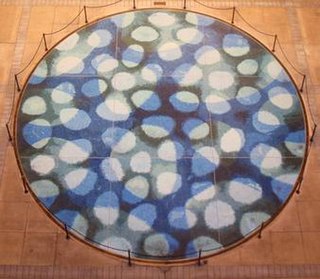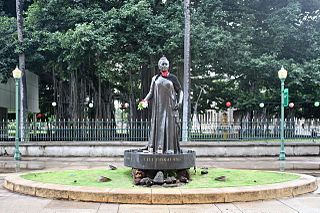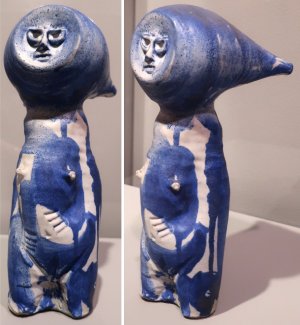
The Hawaii State Senate is the upper house of the Hawaii State Legislature. It consists of twenty-five members elected from an equal number of constituent districts across the islands and is led by the President of the Senate, elected from the membership of the body, currently Ron Kouchi. The forerunner of the Hawaii Senate during the government of the Kingdom of Hawaii was the House of Nobles originated in 1840. In 1894, the Constitution of the Republic of Hawaii renamed the upper house the present senate. Senators are elected to four-year terms and are not subject to term limits.

The Hawaiian archipelago consists of 137 islands in the Pacific Ocean that are far from any other land. Polynesians arrived there one to two thousand years ago, and in 1778 Captain James Cook and his crew became the first Europeans to visit Hawaii. The art created in these islands may be divided into art existing prior to Cook’s arrival; art produced by recently arrived westerners; and art produced by Hawaiians incorporating western materials and ideas. Public collections of Hawaiian art may be found at the Honolulu Museum of Art, the Bishop Museum (Honolulu), the Hawaii State Art Museum and the University of Göttingen in Germany.

Madge Tennent was a naturalized American artist, born in England, raised in South Africa, and trained in France. She ranks among the most accomplished and globally renowned artists ever to have lived and worked in Hawaiʻi.
The Honolulu Museum of Art Spalding House, formerly The Contemporary Museum, Honolulu, was integrated into the Honolulu Museum of Art under this name. It was the only museum in the state of Hawaii devoted exclusively to contemporary art. The Contemporary Museum had two venues: in residential Honolulu at the historic Spalding House, and downtown Honolulu at First Hawaiian Center. All venues continue to be open to the public.

Juliette May Fraser was an American painter, muralist and printmaker. She was born in Honolulu, which was then the capital city of the Kingdom of Hawaii. After graduating from Wellesley College with a degree in art, she returned to Hawaii for several years. She continued her studies with Eugene Speicher and Frank DuMond at the Art Students League of New York and at the John F. Carlson School of Landscape Painting in Woodstock, New York. She returned to Hawaii to teach, like her parents who had both come to Hawaii as educators. Fraser designed the Hawaii Sesquicentennial half dollar, which was sculpted by Chester Beach and issued in 1928.

Tadashi Sato was an American artist. He was born in Kaupakalua on the Hawaiian island of Maui. His father had been a pineapple laborer, merchant, and calligrapher, and Tadashi's grandfather was a sumi-e artist.

Satoru Abe is a Japanese American sculptor and painter.

Alexander Samuel MacLeod (1888–1956) was a painter and printmaker. He was born on Prince Edward Island, Canada on April 12, 1888.

Bumpei Akaji (1921–2002) was an American sculptor from Hawaii. He was known for welding large copper and brass sculptures which can be seen all over Hawaii as part of Hawaii's Art in Public Places program.

The No. 1 Capitol District Building, also known as the Hemmeter Building, is a 134,000-square-foot building (12,400 m2) on two acres (0.81 ha) in downtown Honolulu, Hawaii, United States. Formerly known as the Armed Services YMCA Building, it houses the Capitol Modern Museum, the Hawaii State Foundation on Culture and the Arts, and state offices.
Edward Malcolm Brownlee (1929-2013) was an American sculptor known for his modernist architectural creations with a style influenced by the art of Oceania, Asia, and the Pacific Northwest. He is best known for his work in Hawaii, where he was a frequent collaborator with architect Pete Wimberly.

The John Young Museum of Art is located on the campus of the University of Hawaii at Manoa in Krauss Hall at 2500 Dole Street Honolulu, HI 96822.

Marianna Pineda was an American sculptor, who worked in a stylized realist tradition.
David Kuraoka is an American ceramic artist. He was born in Lihue, Hawaii, grew up on the island of Kauai, Hawaii in Hanamaulu and Lihue, and graduated from Kauai High School in 1964. Kuraoka spent his formative years in Hanamaulu where he lived with his parents in his paternal grandmother's home in a plantation labor camp. His father, one of seven children and the only son, became a journalist, writing a weekly column published on Wednesdays, and the Kauai campaign manager for local politician Hiram Fong and Richard Nixon. His mother, Emiko Kuraoka, was a school teacher. He is married to Carol Kuraoka. Kuraoka moved to California in 1964 to study architecture at San Jose City College, eventually transferring to San José State University where he received his BA in 1970 and MA 1971. After completing graduate work that focused on ceramics, Kuraoka joined the faculty at San Francisco State University, eventually rising to head its ceramics department.

Fred H. Roster was an American sculptor known for his mixed media narrative sculptures.

The Metcalf Chateau, also known as The Group of Seven, was a group of Asian-American artists with ties to Honolulu. The name is derived from a house slated for demolition on Metcalf Street in Honolulu, in which they exhibited in 1954. The exhibition was seen by Robert Griffin, director of the Honolulu Academy of Arts, who arranged for the artists to have a group show at the museum. The group's members were Satoru Abe, Bumpei Akaji (1921-2002), Edmund Chung, Tetsuo Ochikubo (1923-1975), Jerry T. Okimoto (1924-1998), James Park, and Tadashi Sato (1923-2005).

Claude Horan was an American ceramic and glass artist who was born in Long Beach, California. He received a BA from San Jose State University in 1942 and an MA degree in art from Ohio State University in 1946. His wife Suzi Pleyte Horan collaborated on many of the larger projects. He was a lifeguard and longboard surfer in Santa Cruz in the late 1930s, and is credited with naming Steamer Lane.

Aaron Padilla is an American artist and art educator.

Alice Kagawa Parrott was a Japanese American fiber artist and ceramicist. She spent most of her adult life in Santa Fe, New Mexico, where she established a reputation as one of the country's most important weavers, and opened one of Santa Fe's first shops devoted weaving and crafts.
Merle Newport Boyer was an American modernist studio art jeweler and sculptor, as well as inventor, machinist, teacher and mentor.














